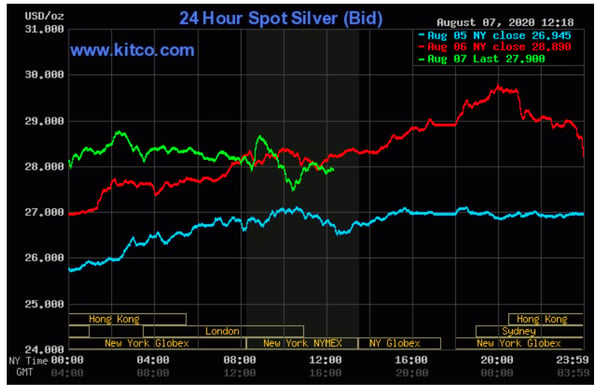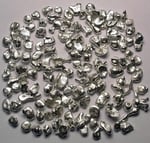“See Spot Run” Up, Up, Up!
Growing up in the ‘70s, I learned to read with the help of Dick, Jane and Spot, characters  created by Zerna Sharp for a series of basal readers. In their heyday of the ‘50s nearly 80% of American school kids learned from these guides and my school continued to use them through the early ‘80s. I vividly remember repeating in front of the class “See Spot Run,” and thinking how cool I was to be able to read it and repeat it. I constantly watched for the opportunity to say “See Spot Run” when it was on the board or in the book: I knew that phrase; I practiced that phrase. Flash-forward to today and you will still catch me repeating “See Spot Run,” only now I am doing it for my job. Nowadays I watch the spot price of silver continuously, and as of late the price is “running” up.
created by Zerna Sharp for a series of basal readers. In their heyday of the ‘50s nearly 80% of American school kids learned from these guides and my school continued to use them through the early ‘80s. I vividly remember repeating in front of the class “See Spot Run,” and thinking how cool I was to be able to read it and repeat it. I constantly watched for the opportunity to say “See Spot Run” when it was on the board or in the book: I knew that phrase; I practiced that phrase. Flash-forward to today and you will still catch me repeating “See Spot Run,” only now I am doing it for my job. Nowadays I watch the spot price of silver continuously, and as of late the price is “running” up.
Spot On
Simply defined, the spot price (in this case silver spot price) is the base price for a raw metal in the marketplace. It is the price at which that metal is traded, bought and sold, and that number is continuously changing. There are numerous factors that influence the spot price of metals, including the economic situation, geopolitical events, availability and environmental conditions. The strength of the dollar also plays a significant role in the valuation of metal prices.
There are gold, silver, platinum and palladium spot prices. While silver and gold are priced and traded on the COMEX or the Commodities Exchange, 24 hours a day, the other precious metals are traded on the NYMEX (New York Mercantile Exchange). The largest over-the-counter market for precious metals is the LBMA (London Bullion Market Association) with well over 200 million troy ounces of silver trade each day.
Current silver spot prices are above $20 per troy ounce after having hovered in the $10 range for years. As the economy fluctuates and more investors turn to precious metals as secure investments, the demand for silver climbs and so do the prices. Here at Osborne Mint, the spot price of silver determines the cost we have to incur to replenish our silver supplies. Logically, as the spot price goes up we have to pay more for this core ingredient of our collectible rounds and bars.

Another consideration for silver purchasing is the immediacy of payment. Because the spot price of silver is ever in flux, payment must be made when the order is placed to lock the spot price. This is across the entire industry from mining, to refining, to investing to creating pieces of art. Once the silver is requested, it is considered purchased and MUST be paid for straightaway, some businesses (like Osborne Mint) allow payment for up to 24 hours.
Silver spot price is the amount one will pay for a single troy ounce of .999 fine silver. The troy ounce contains about 31.1034768 grams of silver, which is slightly higher than the standard ounce which has only 28 grams. This standardization of measurement is believed to have initiated at the Troyes markets in France. This uniformed measurement enabled national and international merchants to trade equally.
Top Spot
Silver is often referred to as “the poor man’s gold,” because of its propensity to  mirror the values of gold. When gold goes up in price, history shows that silver follows suit. Spot pricing for gold exists too and just like for silver it defines the price of gold at that particular point in time in the marketplace.
mirror the values of gold. When gold goes up in price, history shows that silver follows suit. Spot pricing for gold exists too and just like for silver it defines the price of gold at that particular point in time in the marketplace.
For many investors, gold is too rich to purchase in large quantities, while silver can be the perfect substitute for one looking to “bank” precious metals as a security investment.
Silver is considered by economists as one of the most important natural resources in the world, after only water and oil. The medical industry seeks silver for its natural antibacterial properties. Similar to what I wrote about a couple months ago for copper, silver too has the ability to defend against viruses. Fashion yearns for silver because of its timeless appeal and beauty. Mostly, because silver’s industrial usage demands well over 50% of all the available silver each year, the value of this precious metal is determined by its availability, by its supply and demand.
Spot Check
Investing in silver is a decision that has to be made individually, along with the decision of  how you want to invest in it. Do you wish to collect actual ingots (stamped - minimally decorated - bars of silver) or do you wish the more creatively enhanced pieces of art like Osborne Mint’s collectible rounds and bars?
how you want to invest in it. Do you wish to collect actual ingots (stamped - minimally decorated - bars of silver) or do you wish the more creatively enhanced pieces of art like Osborne Mint’s collectible rounds and bars?
Understand that when purchasing collectibles for investment purposes there is a premium attached to the piece. Sure spot price of silver may be at $20 / troy ounce, but a minted round will demand above spot price, you must include the crafting, the art and the manpower to generate such a beautiful piece. Even if you want to store unrefined silver, there is still a premium attached, over and above the spot silver price. Anything and everything, from the mining to packaging, must be accounted for in the final pricing. Spot price represents only the base price for the precious metal.
As with any investment the goal remains the same – to make money by purchasing low and selling high. Currently, the spot price for silver is climbing, making it an opportunistic time to consider selling. If portions of your silver were purchased two or three years ago, you could be in a position to double that money. In fact, any silver purchase after 2013 has the ability to turn a profit with today’s climbing spot price.
Soft Spot
There are a couple types of silver collectors that dominate the scene. One set collects in preparation for the “end.” These “preppers” as they are called, purchase silver, copper and gold in abundance to protect themselves for when the end is near. Silver, like gold, IS money, it is substantial and tangible and unlike a digital promise it cannot be created or deleted. Copper also is a collectible investment tool for preppers primarily for the same reason they purchase silver over gold, copper is less expensive to invest in than silver. They believe that gold, copper and silver will become the only “currency of value” when the world financial markets crumble. Preppers prepare for the worst and feel that their riches will be preserved by their silver, copper and gold reserves.
Some preppers purchase designed collectible rounds to make their preparations more enjoyable and to have “cool things” in their coffers. However, the true collector purchases silver rounds for the art, uniqueness and surreality of the piece. The same holds true for the purchase of copper collectibles. The purchase is as much for the art as it is the copper value. These individuals place an intrinsic value on the collectible above and beyond the current monetary or spot price valuation. They collect these items because they like them and these hold a meaning beyond the weight of the precious metal.
Some collectors focus solely on actual fiat currency, legal tender whose value is backed by the governmental entity that issued it. The value of these pieces is found not only in the weight of the silver but in its assigned value as legal tender. These individuals purchase an insurance of sorts, where the value of the coin (in most cases they are coins) is guaranteed to be no less than the face value of the coin. Even if the spot price of silver drops to pennies on the ounce a US Silver Dollar coin is still worth a dollar – quite literally it is still worth its weight in silver. On the obverse side of the coin, these collectibles are often worth more than both the spot price and the face value. The limited availability or rareness of some coins places their numismatic value at well beyond market numbers. In fact, these pieces can be worth so much more than ever fathomed when placed in a bidding war at an auction. Still, in the eyes of a prepper, the value will likely only be the weight of the piece, and its collectibility will have very limited influence on worth.
Here at Osborne Mint we service all types of collectors and try to appeal to an even wider audience by providing art with a variety of purposes, including memorializing efforts on the homefront during WWII, documenting moments in political history and celebrating human achievement. Our collectibles are more than their spot price – they are coveted pieces of art and deserve to charge a premium.



Spot a Fraud!
Whenever making a purchase of this caliber one has to be diligent and ever aware. Silver purchasing is less commanding monetarily than buying gold, but buyers still have to be careful. There are five primary rules when purchasing silver for collecting, investing or prepping:
- Compare Prices
Spot price shows the going rate for silver, but some businesses require a payment over and above spot price to cover their expenses. This premium varies by supplier. Furthermore, the definition of value can change dramatically if you are purchasing for collectibility due to wear and tear on a coin, the availability and the supplier.
Note: We opened our direct to consumer portal at Osborne Mint in an effort to make purchasing silver collectibles less expensive. Here clients can purchase directly from the mint without a middleman markup. We are also able to control the volume of pieces available, affecting their collectibility and increasing their value over the years.
- Confirm Authenticity
Be on the lookout for counterfeits. Silver can be purchased at bargain prices, but be certain you are really getting what you pay for. Silver can be damaged by poor handling and by chemical mishaps, so be sure that what you are purchasing is quality.
- Watch Like a Hawk!
Watch the spot price of silver before, during and after a purchase. Monitor trends in the industry and economic markets, and compare price evaluations week over week, month over month and year over year to decipher patterns and search for predictabilities. Certainly silver is most often purchased as a long-term investment, but continually track spot prices and be prepared to pounce when the market makes a correction and the opportunity to increase your take presents itself.
- Research the Seller
This tidbit should go without saying. Buy from ONLY a reputable dealer. If you don’t know the seller from Adam, think twice. If you have a feeling something is shady, it probably is. If something is too good to be true, then it IS too good to be true. Purchase from a reputable dealer, research them, find positive testimonials, industry reviews and review their Better Business Bureau report.
- Diversify
We all know to not put all our eggs in one basket, so be smart with your investment. Purchase variable metals, use them in support of your other savings and retirement ventures. Buy not only metal bars but vary your collection with collectible rounds, commemorative pieces and art forms that make your collection more personal and exciting. With Osborne Mint it is easy to bulk purchase artistic rounds and bars in copper and silver – visit Shop-The-Mint and start filling your vault.
Now You Can Spot It
As acknowledged above, the spot price of silver is influenced on many levels. Because silver is used a lot in manufacturing, its availability at a specific point in time can really affect the pricing. If the economy fluctuates up or down the demand for silver will counter and pricing will change. If you see something in silver that you really like, the spot price could become irrelevant when in conflict with your desires. Regardless, the spot price is the definitive evaluation of the price of raw silver in the current market and the spot price provides the basis for which even trade can occur.
To follow the current spot prices of Gold, Silver and Copper on a global scale, go where the professionals go, we use www.KITCO.com.
Who knew that the one phrase I mastered in first grade would be still be in my vocabulary years later, only with a different meaning. See Spot Run!
#Osborne, #OsborneMint, #MadeinAmerica, #Cincinnati, #Collectible, #Silver, #COMEX, #NYMEX, #Investing, #Metal, #Metals, #Mining, #Money, #MarketMoves, #silverandgold, #silverstacking, #silverbullion, #bullion #preciousmetals #spotprice, #fiat, #Copper, #Gold, #PreciousMetals, #KITCO, #SilverPrice




Let Us Know What You Thought about this Post.
Put your Comment Below.